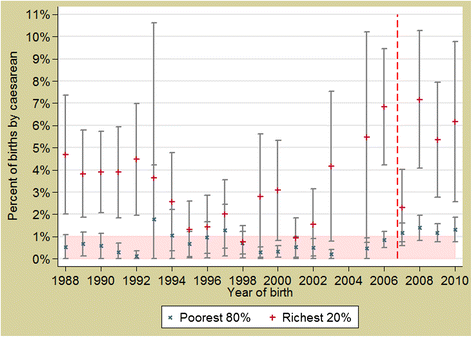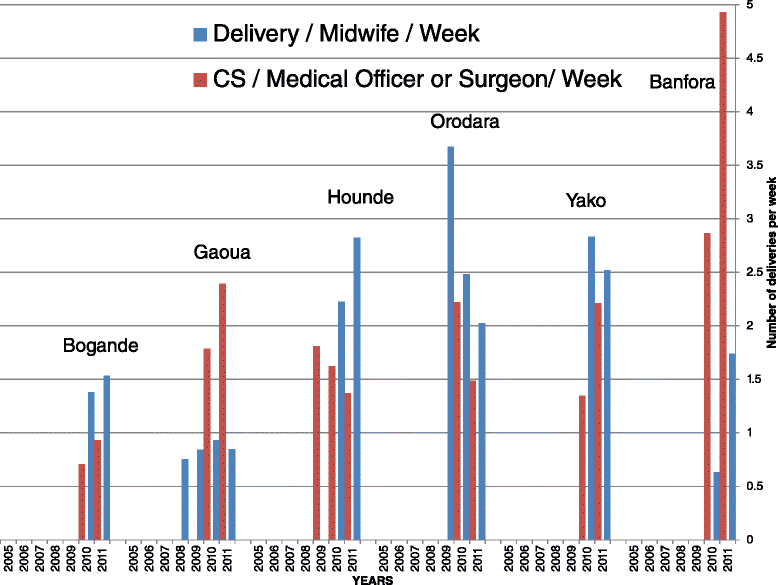The obstetric care subsidy policy in Burkina Faso: what are the effects after five years of implementation? Findings of a complex evaluation
- PMID: 27101897
- PMCID: PMC4840487
- DOI: 10.1186/s12884-016-0875-2
The obstetric care subsidy policy in Burkina Faso: what are the effects after five years of implementation? Findings of a complex evaluation
Abstract
Background: Burkina Faso, like many low and middle income countries, has been taking a range of actions to address its poor maternal and neonatal health indicators. In 2006 the government introduced an innovative national subsidy scheme for deliveries and emergency obstetric care in public facilities. This article reports on a complex evaluation of this policy, carried out 5 years after its introduction, which examined its effects on utilisation, quality of care, equity and the health system as a whole, as well as its cost and sustainability.
Methods: The evaluation was carried out in six purposively selected districts, as well as at national level, using a case study approach. Data sources included: national and district routine and survey data, household interviews with women who had recently given birth, data extraction from hospital and medical records, and key informant and health worker interviews.
Results: The underlying secular trend of a 1% annual increase in the facility-based delivery rate (1988-2010) was augmented by an additional 4% annual increase from 2007 onwards (after the policy was introduced), especially in rural areas and amongst women from poor households. The absence of baseline quality of care data made it difficult to assess the impact of the policy on quality of care, but hospitals with the best level of implementation of the subsidy offered higher quality of care (as measured by health care near-misses), so there is no evidence of a negative impact on quality (as is often feared). Similarly, there is little evidence of unintended negative effects on untargeted services. Household payments for facility-based deliveries have reduced significantly, compared with payments before the policy, and the policy as a whole is affordable, costing about 2% of total public health expenditure. Concerns include that the amounts paid by households are higher than the rates set by the policy, and also that 7% of households still say that they cannot afford to pay. Wealthier women have higher utilisation of services, as before, and the policy of fully exempting indigents is not being put into practice.
Conclusions: These findings highlight the importance of maintaining the subsidy policy, given the evidence of positive outcomes, but they also point out areas where attention is needed to ensure the poor and most vulnerable population benefit fully from the policy.
Keywords: Burkina Faso; Cost of obstetric care; Evaluation; Health system; Maternal health; Policy; Quality of care; Removal of user fees.
Figures





Similar articles
-
Cost and impact of policies to remove and reduce fees for obstetric care in Benin, Burkina Faso, Mali and Morocco.Int J Equity Health. 2016 Aug 2;15(1):123. doi: 10.1186/s12939-016-0412-y. Int J Equity Health. 2016. PMID: 27483993 Free PMC article.
-
Effect of a policy to reduce user fees on the rate of skilled birth attendance across socioeconomic strata in Burkina Faso.Health Policy Plan. 2016 May;31(4):462-71. doi: 10.1093/heapol/czv088. Epub 2015 Oct 8. Health Policy Plan. 2016. PMID: 26453087 Free PMC article.
-
An implementation evaluation of a policy aiming to improve financial access to maternal health care in Djibo district, Burkina Faso.BMC Pregnancy Childbirth. 2012 Dec 8;12:143. doi: 10.1186/1471-2393-12-143. BMC Pregnancy Childbirth. 2012. PMID: 23216874 Free PMC article.
-
[Health system revenue collection in Burkina Faso from 1980 to 2012].Sante Publique. 2014 Sep-Oct;26(5):715-25. Sante Publique. 2014. PMID: 25490231 Review. French.
-
Food Environment in Burkina Faso: Review of Public Policies and Government Actions Using the Food-EPI Tool.Food Nutr Bull. 2024 Jun;45(2-3):74-90. doi: 10.1177/03795721241248214. Epub 2024 May 8. Food Nutr Bull. 2024. PMID: 38716753 Review.
Cited by
-
Performance-based financing to increase utilization of maternal health services: Evidence from Burkina Faso.SSM Popul Health. 2017 Jan 10;3:179-184. doi: 10.1016/j.ssmph.2017.01.001. eCollection 2017 Dec. SSM Popul Health. 2017. PMID: 29349214 Free PMC article.
-
Cost and impact of policies to remove and reduce fees for obstetric care in Benin, Burkina Faso, Mali and Morocco.Int J Equity Health. 2016 Aug 2;15(1):123. doi: 10.1186/s12939-016-0412-y. Int J Equity Health. 2016. PMID: 27483993 Free PMC article.
-
Predictors of exclusive breastfeeding and consumption of soft, semi-solid or solid food among infants in Boucle du Mouhoun, Burkina Faso: A cross-sectional survey.PLoS One. 2017 Jun 22;12(6):e0179593. doi: 10.1371/journal.pone.0179593. eCollection 2017. PLoS One. 2017. PMID: 28640900 Free PMC article.
-
Effect of cost-reduction interventions on facility-based deliveries in Burkina Faso: a controlled interrupted time-series study with multiple non-equivalent dependent variables.J Epidemiol Community Health. 2023 Mar;77(3):133-139. doi: 10.1136/jech-2022-218794. Epub 2022 Dec 20. J Epidemiol Community Health. 2023. PMID: 36539278 Free PMC article.
-
'Rowing against the current': the policy process and effects of removing user fees for caesarean sections in Benin.BMJ Glob Health. 2018 Jan 29;3(1):e000537. doi: 10.1136/bmjgh-2017-000537. eCollection 2018. BMJ Glob Health. 2018. PMID: 29564156 Free PMC article.
References
-
- WHO, UNICEF, UNFPA, The World Bank and the United Nations Population Division. Trends in Maternal Mortality: 1990 to 2013. WHO.2014. http://apps.who.int/iris/bitstream/10665/112697/1/WHO_RHR_14.13_eng.pdf. Accessed 20 Feb 2015
-
- UNICEF: State of The World’s Children 2015 Country Statistical Information. http://www.unicef.org/infobycountry/burkinafaso_statistics.html. Accessed 20 Feb 2015
-
- Ministère de la santé (Burkina Faso) Stratégie nationale subvention des accouchements et des soins obstétricaux et néonatals d’urgence au Burkina. Ouagadougou: Ministère de la santé; 2006.
-
- OlivierDeSardan JP., Ridde V. (dir.). Une politique publique de santé et ses contradictions. La gratuité des soins au Burkina Faso, au Mali et au Niger. Paris: Karthala; 2014. ISBN 9782811112226.
Publication types
MeSH terms
LinkOut - more resources
Full Text Sources
Other Literature Sources

